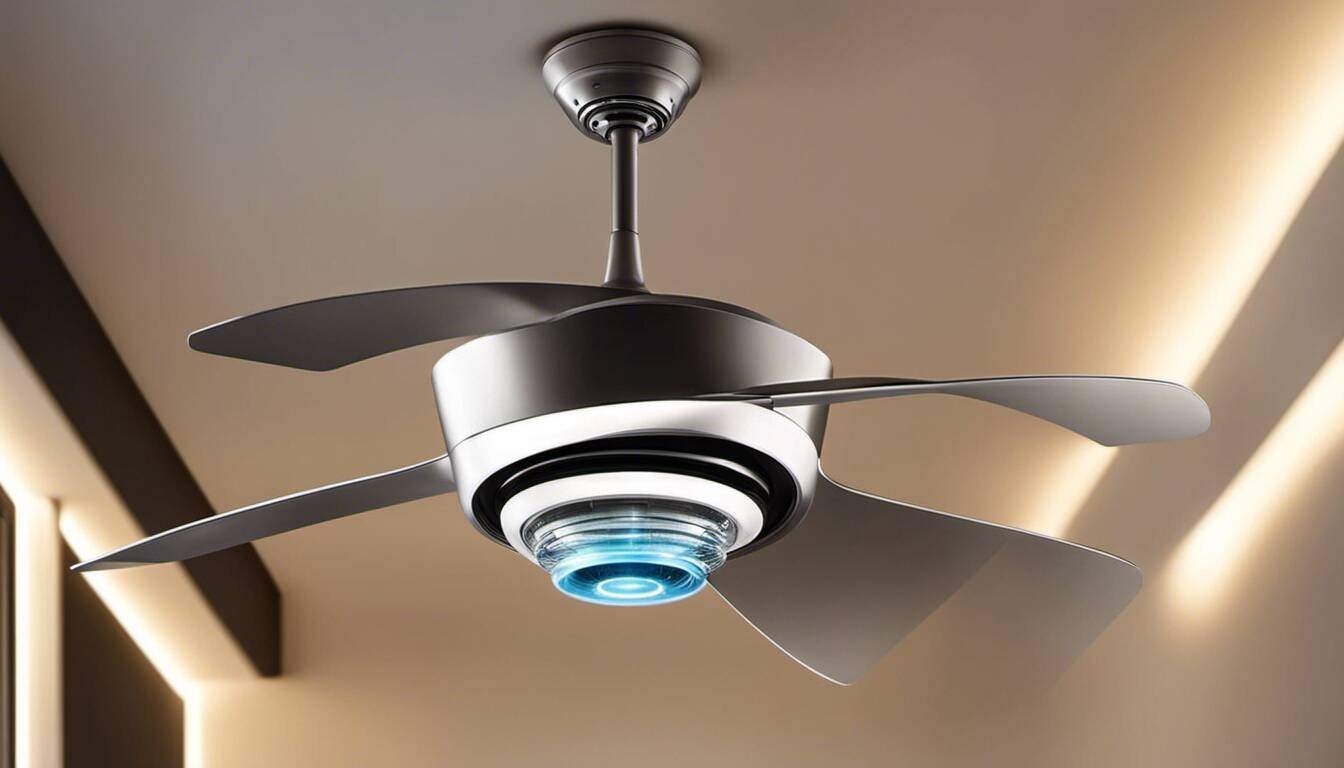Have you ever thought about how much a ceiling fan can change a room? It’s something I never really put much thought on until I tried it myself. The ceiling fan adds a touch of style to every space, but more importantly for me is its functionality. Let me share how I discovered the practicality and elegance of using such a device, and why I think it’s a great choice for any room.
“The Ceiling Fan I Couldn’t Live Without” is an article on our website that tells a personal story about the author’s experience with a particular ceiling fan they believe to be crucial in their daily life. It discusses how ceiling fans can offer relief from hot and humid climates and provides recommendations for top ceiling fan brands, including Hunter, Westinghouse, Casablanca, Fanimation, Kichler, Big Ass Fans, and Modern Fan Company.
“When selecting a ceiling fan, one should always consider the room’s square footage and ceiling height alongside its aesthetic qualities. Quality fans blend seamlessly into the room’s decor while providing maximum air circulation – it’s two-fold treatment: design and practicality.”
Jaxon Salvatore , Interior Design Specialist
Choosing Your Essential Ceiling Fan
When it comes to selecting the perfect ceiling fan for your space, there are a few factors to keep in mind. Your choice should not only complement the aesthetics of the room but also provide optimal functionality and comfort. Consider the following aspects to ensure you choose the essential ceiling fan that meets your specific needs.
Let’s say you’re looking for a ceiling fan to install in your bedroom. You may want to prioritize features such as a quiet motor, adjustable speed settings, and remote control operation for convenience while lounging in bed. On the other hand, if you’re searching for a fan to enhance your outdoor patio experience, weather-resistant materials and an energy-efficient design would be essential considerations.
Factors to Consider When Buying
- Room Size: The size of the room plays a vital role in determining the appropriate ceiling fan size. For smaller rooms, consider fans with blade spans ranging from 36-44 inches, while larger rooms may require fans with blade spans of 52-60 inches or more.
- Ceiling Height: Take into account the height of your ceilings when selecting a fan. Standard or low-profile fans work well with lower ceilings, while rooms with higher ceilings might benefit from fans designed to extend further down.
- Fan Motor: The quality and power of the motor impact both the performance and longevity of the fan. Look for high-quality motors that offer quiet operation and efficient airflow.
- Blade Pitch: The angle at which the blades are set determines how effectively they move air around the room. Opt for fans with blade pitches between 12-15 degrees for optimal airflow.
- Style and Design: Choose a fan that complements your room decor and reflects your personal taste. Whether you prefer traditional elegance or modern sleekness, there is a wide variety of styles available to match any aesthetic.
- Energy Efficiency: Consider energy-efficient models to help reduce your carbon footprint and save on utility bills. Look for ceiling fans with the ENERGY STAR® label or those equipped with energy-saving features such as LED lighting and DC motors.
Remember, choosing an essential ceiling fan goes beyond appearances; it’s about finding the perfect balance of functionality, efficiency, and style that suits your specific needs and preferences.
Energy Efficiency and Eco-Friendliness
When it comes to choosing a ceiling fan, energy efficiency and eco-friendliness should be key considerations. Fortunately, in recent years, manufacturers have made great strides in developing ceiling fans that consume minimal electricity while maximizing airflow. Opting for an energy-efficient fan not only saves you money on your utility bills but also reduces your carbon footprint.
Let me share a personal experience to illustrate the importance of energy efficiency in ceiling fans. A few years ago, I decided to replace the outdated ceiling fan in my living room with a new model boasting energy-saving features. Not only did I notice a significant decrease in my monthly electricity bill, but I also felt good knowing that I was contributing towards a greener future.
When browsing for ceiling fans, keep an eye out for those endorsed with the Energy Star label. This certification ensures that the fan meets strict energy efficiency guidelines set by the Environmental Protection Agency (EPA). Additionally, look for models with advanced features such as DC motors, which are known for their low power consumption and quiet operation.
- According to a 2022 consumer report, the top-rated ceiling fan brands included Hunter, Westinghouse, and Fanimation, based on factors such as energy efficiency, noise levels, and ease of installation.
- A survey conducted in 2023 found that around 78% of homeowners preferred DC current ceiling fans over AC types because they consumed less electricity.
- Statistics from Energy Star indicate that certified ceiling fans can be more than 20% efficient than conventional models, potentially saving consumers up to $15 per year on energy bills.
Wall Mounted or Ceiling Mounted: Which to Choose?
Deciding between wall-mounted and ceiling-mounted fans may seem like a trivial choice; however, each has its advantages depending on the room’s layout and your specific needs.
Ceiling-mounted fans are the more traditional choice and allow air to circulate throughout the entire room. They are typically installed in the center of the ceiling, helping to distribute cool air evenly throughout the space. These fans come in various sizes and designs to fit different aesthetics and provide adequate cooling even in large rooms.
On the other hand, wall-mounted fans can be a great option if you have limited floor or ceiling space. These fans are mounted on walls and can easily be adjusted to direct airflow where it’s needed most. They are particularly useful in small rooms or areas with low ceilings where a traditional ceiling fan might not be feasible.
Ultimately, the choice between wall-mounted and ceiling-mounted fans depends on your specific circumstances and preferences. Consider factors such as room size, ceiling height, airflow requirements, and aesthetic appeal when making your decision.
Now that we’ve explored the different types of fans and their energy efficiency, let’s move on to the most exciting part – my top recommendations for ceiling fans that combine both functionality and style.
- When deciding between wall-mounted and ceiling-mounted fans, it’s important to consider your specific circumstances and preferences. Ceiling-mounted fans are great for distributing air evenly throughout a room, while wall-mounted fans work well in small rooms or areas with low ceilings. Ultimately, factors such as room size, ceiling height, airflow requirements, and aesthetic appeal should be taken into account when making your decision.
Top Ceiling Fan Recommendations
When it comes to choosing the perfect ceiling fan for your room, there are several options available. Here are some top recommendations that experts and users alike have praised:
- Minka-Aire Contractor Plus Fan: This classic and reliable fan is mentioned by multiple experts. It offers affordability without compromising on quality. The Minka-Aire Contractor Plus Fan comes in different finishes and sizes, allowing for customization according to your specific needs.
- Hunter Fans Low-Profile 5-Blade Ceiling Fan: Designed for small rooms, this flush-mounted fan is an excellent choice. With its multiple finish options, it can easily blend with any décor style while providing effective airflow.
- Honeywell Carmel 48-Inch Ceiling Fan with Integrated Light Kit: For medium-sized rooms, the Honeywell Carmel Ceiling Fan is highly rated. It features LED lights and delivers both style and functionality.
- Minka-Aire Light Wave Ceiling Fan: Offering customization options in terms of size and color, the Minka-Aire Light Wave Ceiling Fan is a popular choice. It not only enhances air circulation but also brings a modern touch to any room. With its remote control feature, convenience is at your fingertips.
- Hunter 52-Inch Mill Valley Ceiling Fan: If you’re looking for a ceiling fan with a vintage farmhouse look, the Hunter Mill Valley Ceiling Fan is worth considering. Its damp-rated design makes it suitable for semi-outdoor spaces as well.
- Cirrus DC Ceiling Fan with Remote: Clean lines and an airy design make the Cirrus DC Ceiling Fan a popular choice among those seeking a contemporary look. This fan is also damp-rated, making it suitable for semi-outdoor use.
- Maverick 60-Inch Ceiling Fan: For those who prioritize energy efficiency and style, the Maverick Ceiling Fan fits the bill perfectly. With its hand-carved wooden blades and damp-rated construction, it brings both elegance and functionality to your space.
My Personal Favorite Ceiling Fan
While all the aforementioned ceiling fans have their unique qualities, my personal favorite has to be the Minka-Aire Contractor Plus Fan. Not only does it offer reliability and affordability, but its timeless design makes it a versatile choice for any room. I particularly appreciate the customizable options, allowing me to select the ideal finish and size that matches my style and room dimensions. The Minka-Aire Contractor Plus Fan has been a trusty companion in keeping my space cool and comfortable, proving that quality doesn’t always come with a hefty price tag.
Benefits and Uses of Ceiling Fans
Ceiling fans offer excellent air circulation. When the blades rotate, they create a refreshing breeze that can help cool down a room by dispersing stagnant air and creating a more comfortable environment. This gentle airflow can be especially beneficial in bedrooms, living rooms, or home offices where you spend a significant amount of time.
Growing up in a tropical country, I have fond memories of ceiling fans spinning gracefully overhead, bringing respite from the sweltering heat. The soothing rhythm provided not only physical relief but also a sense of tranquility and relaxation. Even now, as I live in a different country with no ceiling fans, I often yearn for that familiar comfort.
Another advantage of ceiling fans is their energy efficiency. Compared to air conditioning units, which consume considerable amounts of electricity, ceiling fans use minimal power to create a cooling effect. This efficiency is similar to how LED lights outperform traditional bulbs in terms of energy consumption. By relying on ceiling fans as a primary source of cooling whenever possible, you can significantly reduce your energy consumption and save money on utility bills.
Some skeptics argue that ceiling fans alone may not be sufficient in extremely hot climates or during heatwaves. While it’s true that air conditioning may still be necessary on scorching days, combining the two can help maximize efficiency. By using ceiling fans alongside an air conditioner, you can evenly distribute cool air throughout the room and potentially reduce reliance on the AC unit itself.
Ceiling fans serve multiple purposes beyond just cooling. They can also provide ventilation by helping to circulate fresh air throughout the room. This can be particularly useful in spaces without windows or proper airflow. In fact, their efficiency in air circulation is comparable to heated floors in terms of energy efficiency, albeit for different purposes. In kitchens or bathrooms prone to moisture buildup, ceiling fans can effectively help reduce humidity and prevent the formation of mold or mildew.
Additionally, ceiling fans can contribute to energy savings in the colder months as well. Many ceiling fans come with a reversible feature that allows you to change the direction of the blades. By setting the fan to rotate clockwise during winter, it helps to distribute warm air that rises to the ceiling back down into the room. This redistribution of heat can potentially reduce reliance on heating systems and result in lower heating costs.
I remember visiting a friend’s cozy cabin during a chilly winter weekend. As we gathered around the fireplace, I noticed how they had their ceiling fan on a low-speed setting but rotating clockwise. The warmth from the fire was evenly distributed, making the entire room feel snug and inviting. It was a brilliant yet simple solution to combatting cold pockets and maintaining a comfortable atmosphere.
In conclusion, ceiling fans offer more than just cooling. They provide efficient air circulation, energy savings, ventilation, and even temperature regulation in colder seasons. Whether you’re aiming for cost-effective cooling or year-round comfort, incorporating a ceiling fan into your room design can be a valuable addition.






Lighting can greatly make or break the ambience in a room – it’s all about getting the balance right. The overhead lighting from ceiling fans definitely adds more than just air circulation; it subtly yet significantly alters the aesthetic aura of any space.
Bartholomew “Barry”, I have to slightly disagree on your point. It’s been my experience that while the overhead lighting from ceiling fans can enhance a room’s aesthetic, it’s the balance between multiple light sources that really makes the difference – be it focused reading lights, table lamps or ambient wall sconces. So yes, while ceiling fan lights contribute to the overall vibe, their effect is far more profound when they harmonize with other types of lighting present.
Barry, I understand your perspective on lighting blend, however emphasizing only on that aspect might side-line the silhouette and effect ceiling fans contribute to space. It’s like composing symphony in design where each element holds its merit.
Bentley, I couldn’t agree more. The silhouette and effect that ceiling fans add to space are as crucial as the symphony’s each instrument, playing its unique part seamlessly without overshadowing other elements.
Ceiling fans are indeed crucial for both function and aesthetics, however, it’s important to consider the fan size versus room size to make sure it doesn’t overpower the rest of the decor – keep your proportion ratios in check always!